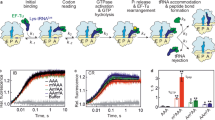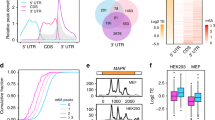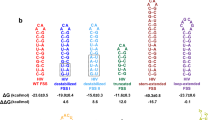Abstract
N6-methylation of adenosine (forming m6A) is the most abundant post-transcriptional modification within the coding region of mRNA, but its role during translation remains unknown. Here, we used bulk kinetic and single-molecule methods to probe the effect of m6A in mRNA decoding. Although m6A base-pairs with uridine during decoding, as shown by X-ray crystallographic analyses of Thermus thermophilus ribosomal complexes, our measurements in an Escherichia coli translation system revealed that m6A modification of mRNA acts as a barrier to tRNA accommodation and translation elongation. The interaction between an m6A-modified codon and cognate tRNA echoes the interaction between a near-cognate codon and tRNA, because delay in tRNA accommodation depends on the position and context of m6A within codons and on the accuracy level of translation. Overall, our results demonstrate that chemical modification of mRNA can change translational dynamics.
This is a preview of subscription content, access via your institution
Access options
Subscribe to this journal
Receive 12 print issues and online access
$189.00 per year
only $15.75 per issue
Buy this article
- Purchase on Springer Link
- Instant access to full article PDF
Prices may be subject to local taxes which are calculated during checkout






Similar content being viewed by others
References
Moore, M. From birth to death: the complex lives of eukaryotic mRNAs. Science 309, 1514–1518 (2005).
Deng, X. et al. Widespread occurrence of N6-methyladenosine in bacterial mRNA. Nucleic Acids Res. 43, 6557–6567 (2015).
Dominissini, D. et al. Topology of the human and mouse m6A RNA methylomes revealed by m6A-seq. Nature 485, 201–206 (2012).
Jia, G., Fu, Y. & He, C. Reversible RNA adenosine methylation in biological regulation. Trends Genet. 29, 108–115 (2013).
Meyer, K.D. et al. Comprehensive analysis of mRNA methylation reveals enrichment in 3′ UTRs and near stop codons. Cell 149, 1635–1646 (2012).
Wang, X. et al. N6-methyladenosine modulates messenger RNA translation efficiency. Cell 161, 1388–1399 (2015).
Bokar, J. in Fine-Tuning of RNA Functions by Modification and Editing Vol. 12 (ed. Grosjean, H.) 141–177 (Springer, 2005).
Karikó, K., Buckstein, M., Ni, H. & Weissman, D. Suppression of RNA recognition by Toll-like receptors: the impact of nucleoside modification and the evolutionary origin of RNA. Immunity 23, 165–175 (2005).
Zheng, G. et al. ALKBH5 is a mammalian RNA demethylase that impacts RNA metabolism and mouse fertility. Mol. Cell 49, 18–29 (2013).
Batista, P.J. et al. m6A RNA modification controls cell fate transition in mammalian embryonic stem cells. Cell Stem Cell 15, 707–719 (2014).
Fustin, J.-M. et al. RNA-methylation-dependent RNA processing controls the speed of the circadian clock. Cell 155, 793–806 (2013).
Jia, G. et al. N6-methyladenosine in nuclear RNA is a major substrate of the obesity-associated FTO. Nat. Chem. Biol. 7, 885–887 (2011).
Wang, X. et al. N6-methyladenosine-dependent regulation of messenger RNA stability. Nature 505, 117–120 (2014).
Wang, Y. et al. N6-methyladenosine modification destabilizes developmental regulators in embryonic stem cells. Nat. Cell Biol. 16, 191–198 (2014).
Zhao, X. et al. FTO-dependent demethylation of N6-methyladenosine regulates mRNA splicing and is required for adipogenesis. Cell Res. 24, 1403–1419 (2014).
Niu, Y. et al. N6-methyl-adenosine (m6A) in RNA: an old modification with a novel epigenetic function. Genomics Proteomics Bioinformatics 11, 8–17 (2013).
Schwartz, S. et al. High-resolution mapping reveals a conserved, widespread, dynamic mRNA methylation program in yeast meiosis. Cell 155, 1409–1421 (2013).
Roost, C. et al. Structure and thermodynamics of N6-methyladenosine in RNA: a spring-loaded base modification. J. Am. Chem. Soc. 137, 2107–2115 (2015).
Liu, N. et al. N6-methyladenosine-dependent RNA structural switches regulate RNA-protein interactions. Nature 518, 560–564 (2015).
Spitale, R.C. et al. Structural imprints in vivo decode RNA regulatory mechanisms. Nature 519, 486–490 (2015).
Chen, J. et al. High-throughput platform for real-time monitoring of biological processes by multicolor single-molecule fluorescence. Proc. Natl. Acad. Sci. USA 111, 664–669 (2014).
Johansson, M., Zhang, J. & Ehrenberg, M. Genetic code translation displays a linear trade-off between efficiency and accuracy of tRNA selection. Proc. Natl. Acad. Sci. USA 109, 131–136 (2012).
Blanchard, S.C., Gonzalez, R.L., Kim, H.D., Chu, S. & Puglisi, J.D. tRNA selection and kinetic proofreading in translation. Nat. Struct. Mol. Biol. 11, 1008–1014 (2004).
Chen, J., Petrov, A., Tsai, A., O'Leary, S.E. & Puglisi, J.D. Coordinated conformational and compositional dynamics drive ribosome translocation. Nat. Struct. Mol. Biol. 20, 718–727 (2013).
Uemura, S. et al. Real-time tRNA transit on single translating ribosomes at codon resolution. Nature 464, 1012–1017 (2010).
Vendeix, F.A. et al. Human tRNA(Lys3)(UUU) is pre-structured by natural modifications for cognate and wobble codon binding through keto-enol tautomerism. J. Mol. Biol. 416, 467–485 (2012).
Demirci, H. et al. Modification of 16S ribosomal RNA by the KsgA methyltransferase restructures the 30S subunit to optimize ribosome function. RNA 16, 2319–2324 (2010).
Wimberly, B.T. et al. Structure of the 30S ribosomal subunit. Nature 407, 327–339 (2000).
Johansson, M. et al. pH-sensitivity of the ribosomal peptidyl transfer reaction dependent on the identity of the A-site aminoacyl-tRNA. Proc. Natl. Acad. Sci. USA 108, 79–84 (2011).
Lee, T.H., Blanchard, S.C., Kim, H.D., Puglisi, J.D. & Chu, S. The role of fluctuations in tRNA selection by the ribosome. Proc. Natl. Acad. Sci. USA 104, 13661–13665 (2007).
Kim, S.J. et al. Translational tuning optimizes nascent protein folding in cells. Science 348, 444–448 (2015).
Otwinowski, Z. & Minor, W. Processing of X-ray diffraction data collected in oscillation mode. Methods Enzymol. 276, 307–326 (1997).
Adams, P.D. et al. PHENIX: a comprehensive Python-based system for macromolecular structure solution. Acta Crystallogr. D Biol. Crystallogr. 66, 213–221 (2010).
Kurata, S. et al. Modified uridines with C5-methylene substituents at the first position of the tRNA anticodon stabilize U.G wobble pairing during decoding. J. Biol. Chem. 283, 18801–18811 (2008).
Emsley, P., Lohkamp, B., Scott, W.G. & Cowtan, K. Features and development of Coot. Acta Crystallogr. D Biol. Crystallogr. 66, 486–501 (2010).
Marshall, R.A., Dorywalska, M. & Puglisi, J.D. Irreversible chemical steps control intersubunit dynamics during translation. Proc. Natl. Acad. Sci. USA 105, 15364–15369 (2008).
Dorywalska, M. et al. Site-specific labeling of the ribosome for single-molecule spectroscopy. Nucleic Acids Res. 33, 182–189 (2005).
Aitken, C.E. & Puglisi, J.D. Following the intersubunit conformation of the ribosome during translation in real time. Nat. Struct. Mol. Biol. 17, 793–800 (2010).
Aitken, C.E., Marshall, R.A. & Puglisi, J.D. An oxygen scavenging system for improvement of dye stability in single-molecule fluorescence experiments. Biophys. J. 94, 1826–1835 (2008).
Kurland, C.G. & Ehrenberg, M. Optimization of translation accuracy. Prog. Nucleic Acid Res. Mol. Biol. 31, 191–219 (1984).
Johansson, M., Bouakaz, E., Lovmar, M. & Ehrenberg, M. The kinetics of ribosomal peptidyl transfer revisited. Mol. Cell 30, 589–598 (2008).
Acknowledgements
This work was supported by US National Institutes of Health (NIH) grants GM51266 and GM099687 to J.D.P.; by grants from the Knut and Alice Wallenberg Foundation (RiboCORE) and the Swedish Research Council and the Human Frontier Science Program to M.E.; by NIH grants GM111858 to S.E.O'L.; by grants from the Israel Science Foundation (ISF) grant no. 1667/12), the Israeli Centers of Excellence (I-CORE) Program (ISF grants no. 41/11 and no. 1796/12) and the Ernest and Bonnie Beutler Research Program to G.R.; by a Human Frontier Science Program long-term fellowship to D.D.; and by a Stanford Bio-X fellowship to J. Choi. Portions of this research were carried out at the Stanford Synchrotron Radiation Lightsource (SSRL), a national user facility operated by Stanford University on behalf of the US Department of Energy, US Office of Basic Energy Sciences. The SSRL Structural Molecular Biology Program is supported by the US Department of Energy, Office of Biological and Environmental Research, NIH, US National Center for Research Resources, Biomedical Technology Program, and the US National Institute of General Medical Sciences. G.R. is supported as a member of the Sagol Neuroscience Network and by the Kahn Family Foundation. We thank P. Agris (University of Albany) for a human ASL reagent and members of Puglisi laboratory for discussion. J. Choi thanks J.B. Choi for support.
Author information
Authors and Affiliations
Contributions
J. Choi, K.-W.I. and H.D. performed all the experiments and the data analysis; J. Choi performed single-molecule experiments; K.-W.I. performed bulk kinetic experiments; H.D. performed X-ray crystallography, with the help of S.M.S. in material preparations. D.D. and G.R. provided reagents and conceived the project with J. Choi, K.-W.I., H.D., J. Chen, M.E. and J.D.P. J. Chen, A. Petrov and A. Prabhakar assisted in reagent preparation. J. Choi, K.-W.I., H.D., S.E.O'L., M.E. and J.D.P. wrote manuscript.
Corresponding author
Ethics declarations
Competing interests
The authors declare no competing financial interests.
Integrated supplementary information
Supplementary Figure 1 Comparing rotated- and nonrotated-state lifetimes among mRNA m6A modifications in different codon contexts.
a. mRNA sequences used for each experiments, as same as shown in Figure 2a.
b. The rotated state and non-rotated state lifetime measurements for all codons in the mRNAs used. First row shows the non-rotated state lifetimes for each codons within the mRNAs, and second row shows the rotated state lifetimes for each codons within the mRNAs. Last row shows the number of ribosomes observed to reach particular codon during translation prior to photobleaching of reporter fluorescence dye.
Supplementary Figure 2 Geometry of the m6A-uridine Watson-Crick base-pair interactions.
The final σA-weighted m2Fo-dFc electron density map contoured at 1σ level shows that a. m6A1•U36, b. m6A•U35 and c. m6A•mcm5s2U34 base pairs are in the Watson-Crick geometry. ASL carbons are colored wheat and mRNA carbons are gray. d. The overlay of all structures reveals a nearly identical orientation of the codon:anticodon interaction). The ASLLys3UUU –AAA complex (colored in gray), the ASLLys3UUU – (m6A)AA (colored in light pink), ASLLys3UUU–A(m6A)A (colored in cyan) and ASLLys3UUU–AA(m6A) (colored in green) are superposed and aligned with respect to the 16S rRNA.
Supplementary Figure 3 Proofreading of tRNALys ternary complexes reading (m6A)AA.
Dipeptide formation was measured at 1µM ribosomes and 0.5 µM ternary complexes. Experiments were done in parallel using the very same ternary complexes reacting with initiation complexes displaying AAA or (m6A)AA codon in the A site. The lower plateau of dipeptide fMet-Lys formation for (m6A)AA indicates the rejection of tRNALys after GTP hydrolysis.
a. Experiments were done in low Mg2+ buffer (see Methods). Proofreading factor, f = 1.5, was calculated as the ratio between the plateaus of dipeptide formation for AAA and (m6A)AA.
b. Same experiment was performed in high Mg2+ buffer (see Methods), where proofreading factor was measured to be f = 1.3.
Supplementary Figure 4 Reducing decoding accuracy reduces the effect of m6A on translational dynamics in high-Mg2+ conditions.
(a) Kinetics of GTP hydrolysis after binding of Lys-tRNALys ternary complexes (0.2 µM) to 70S initiation complexes (0.7µM) programmed with AAA or (m6A)AA in the A site. (b) Estimates of kcat/KM-values for GTP hydrolysis. (c) and (d) Kinetics of GTP hydrolysis and dipeptide fMet-Lys formation measured simultaneously in the very same experiment. The grey areas represent the total time for all subsequent steps after GTP hydrolysis up to and including peptidyl transfer. (e) Estimates of the compounded rate constant, kpep, for the steps after GTP hydrolysis on EF-Tu up to and including peptidyl transfer, from experiments shown in c and d. See Supplementary Data Table 1 for data in b and e. Kinetic data in a, c, and d are representative of three independent experiments. Error bars in b and e represent SD (n = 3, technical replicates) as calculated from the fitting procedure (Johansson, M. et al. Proc. Natl. Acad. Sci. U. S. A. 108, 79–84 (2011)).
Supplementary Figure 5 m6A shifts FRET value between P-site tRNA and A-site tRNA in the GTPase-activated state.
FRET histogram of the GDPNP-induced prolonged GTPase-activated state and codon-recognition states for unmodified (left) and first-base m6A modified (right) cases at 15mM magnesium concentration. Values inserted indicate fitted center of Gaussian distribution to histogram, and values in parenthesis indicate 95% confidence interval of fitting. While peaks near 0 FRET efficiency indicates no FRET state, peaks near 0.6 FRET efficiency corresponds to GTPase-activated state. FRET efficiency decreases slightly from 0.643 to 0.585 when cognate AAA codon is modified to (m6A)AA codon, mirroring previous comparison between cognate and near-cognate pairing on Phe (Lee, T., Blanchard, S. C., Kim, H. D., Puglisi, J. D. & Chu, S. The role of fluctuations in tRNA selection by the ribosome. Proc. Natl. Acad. Sci. 104, 13661–13665 (2007)).
Supplementary Figure 6 tRNA-tRNA FRET lifetime decreases severely with m6A at low magnesium.
Comparing representative synchronized FRET time evolution between different conditions. Low magnesium condition aggravates the effect of m6A in tRNA recognition by increasing accuracy of tRNA selection of ribosome (top left, top middle panel), which inverts ratio between successful accommodation event and transient sampling event compared to high magnesium condition. When decoding is further hindered by GDPNP at low magnesium condition, FRET lifetime at GTPase-activated state decreases and the effect of m6A cannot be detected accurate in our current time resolution of 100 millisecond; decreased FRET event lifetime due to m6A might be less than 100 millisecond, which our measurement would only sample long-lived FRET events rather than giving a correct lifetime. We also performed tRNA FRET between P site fMet-(Cy3)tRNAfMet and A site Phe-(Cy5)tRNAPhe binding to UUC codon at A site, similar to previously published result for comparison (rightmost two panels). Number of FRET events post-synchronized for each experiment is 316, 213, 497, 577, 221, and 781 for GTP-AAA, GTP-(m6A)AA, GDPNP-AAA, GDPNP-(m6A)AA, GTP-UUC and GDPNP-UUC, respectively.
Supplementary information
Supplementary Text and Figures
Supplementary Figures 1–6 and Supplementary Table 1 (PDF 790 kb)
Rights and permissions
About this article
Cite this article
Choi, J., Ieong, KW., Demirci, H. et al. N6-methyladenosine in mRNA disrupts tRNA selection and translation-elongation dynamics. Nat Struct Mol Biol 23, 110–115 (2016). https://doi.org/10.1038/nsmb.3148
Received:
Accepted:
Published:
Issue Date:
DOI: https://doi.org/10.1038/nsmb.3148
This article is cited by
-
RNA modification-mediated mRNA translation regulation in liver cancer: mechanisms and clinical perspectives
Nature Reviews Gastroenterology & Hepatology (2024)
-
Specific RNA m6A modification sites in bone marrow mesenchymal stem cells from the jawbone marrow of type 2 diabetes patients with dental implant failure
International Journal of Oral Science (2023)
-
Modulation of translational decoding by m6A modification of mRNA
Nature Communications (2023)
-
O-GlcNAcylation determines the translational regulation and phase separation of YTHDF proteins
Nature Cell Biology (2023)
-
RNA modification in cardiovascular disease: implications for therapeutic interventions
Signal Transduction and Targeted Therapy (2023)



